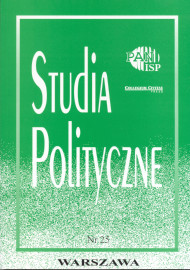Rywalizacja polityczna w Polsce w latach 2007–2009
Political rivalry in Poland in 2007–2009
Author(s): Marek GórkaSubject(s): Politics / Political Sciences
Published by: Instytut Studiów Politycznych PAN
Summary/Abstract: When subjecting the character of transformation of the contemporary party system in Poland to scrutiny, it is worthwhile attracting the reader’s attention to the political rivalry, which, on the one hand, reflects the social and demographic splits of the elector population, and on the other hand, mirrors the links and relations between the parties in the political system. What changed in 2007–2009 was not only the hitherto model of the rivalry at the government level, in respect of the patterns of forming coalitions and political alliances; the bi-polar model of rivalry at the level of the parties’ electorates evolved too. The issues which are often omitted or ignored are significant, bearing in mind that they are an important factor shaping the model of political rivalry, e.g. the impact of the media and the professionalisation of politics. The specific features of electoral rivalry are undoubtedly also influenced by the on-going generational change of Polish electors, as well as the parallel process of applying new communication and technological solutions in the political struggle. This paper aims at an analysis of the transformations of the party system in Poland, which originate in the electoral battle in 2005, with their apogeum falling during the electoral campaign in 1997. The previous political rivalry, based on stabilised relations between the ‘post-August’ camp on the one hand and the ‘post-Communist’ camp on the other, began losing its saliency. The question regarding the future scenario of political events and the dualist model of political rivalry between the Civic Platform and the Law and Justice party is thus a weighty one. The marginalisation of the left side of the political scene, commenced in 2005, as well as the unattained Civic Platform and Law and Justice coalition, are not without their impact on the formation of the party system in Poland. The text thus points to the continuation of the political processes ongoing in the Polish party system in 2007–2009. Although the events analysed are still fresh and more time has to pass for them to be described in full, it is worthwhile even today to give a thought to the issues related to the emergence of the new model of political rivalry.
Journal: Studia Polityczne
- Issue Year: 2010
- Issue No: 25
- Page Range: 185-203
- Page Count: 19
- Language: Polish

